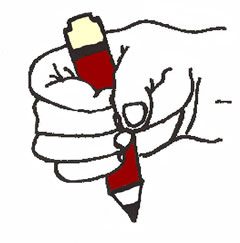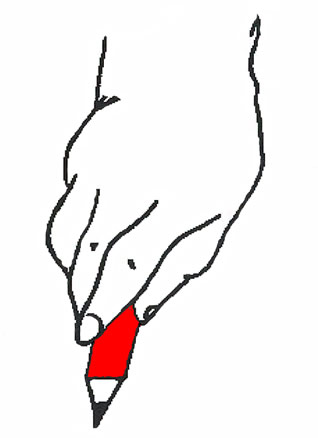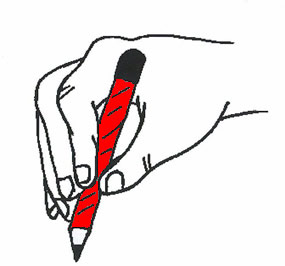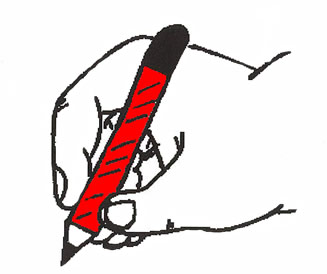Fine motor skills and handwriting
The development of fine motor skills in person's learning to write are exemplified by the four positional grasps that their hands go through.
These four stages reflect the development of the fine motor skills from the developed gross motor skills.
Fisted grasp

This is the general way that younger learners will grasp crayons and other writing tools during their first experiences. The movement of the crayon comes from gross motor skills (i.e. the shoulder). The grasp allows maximum movement but does not suit those who require more precision in their work to achieve detailed drawings or legible writing.
Skills required for further development:
- body and shoulder stability
- increased wrist strength
- enhanced wrist position
- increased hand strength
Pronated grasp

Pronated means the palm of the hand is facing down. This grasp is the next stage and the crayon or pencil is held more by the fingers that the is evident in the fisted grasp. This occurs when the user has developed better control of the small hand muscles. Most of the movement still comes from gross motor action (i.e. the arm) but the xx development is evident with control moving closer to the fingers.
Skills required for further development:
- increased wrist strength
- better wrist position
- increased hand strength
- beginning separation of the two sides of the hand
Static Quadripod/Tripod grasp

This grasp becomes more efficient. Quadripod means that there are four fingers on the crayon or pencil while tripod means three fingers are used. The tripod grasp is the mature grasp. The pencil is usually held away from the tip (i.e. writing end). To develop this grasp learners have to have the ability to use their fingers with come precision and strength. Most of the movement has moved to the whole hand and fingers moving in unison. The term 'static' comes from the fact that the small muscles of the fingers are not generally responsible for controlling the movement, i.e. these finger muscle groups are 'static'.
Skills required for further development:
- increased hand strength, especially the thumb
- further development of the intrinsic (small) muscles in the hand
- further development of open web spaces (between the fingers)
- separation of two sides of thehand
- control of pressure
Dynamic Quadripod/Tripod grasp

| Age guide: | 3½ - 4½ years (dynamic quadripod) |
| 4½ - 6 years (dynamic tripod) |
The dynamic quadripod grasp is less mature than the dynamic tripod grasp. This grasp usually hold the pencil closer to the tip then the previous static grasp. There is generally more movement of the fingers.
The dynamic tripod grasp is the most efficient grip. It involes the thumb, index and middle fingers controlling pencil movement while the arm and wrist are used to maintain positioning. It is unlikely that the dynamic tripod grasp will be fully developed before a child enters school.
Skills required for further development:
- increased hand strength, especially the thumb
- further development of the intrinsic (small) muscles in the hand
- further development of open web spaces (between the fingers)
- separation of two sides of the hand
- control of pressure
- formal modelling to assist in refining grip